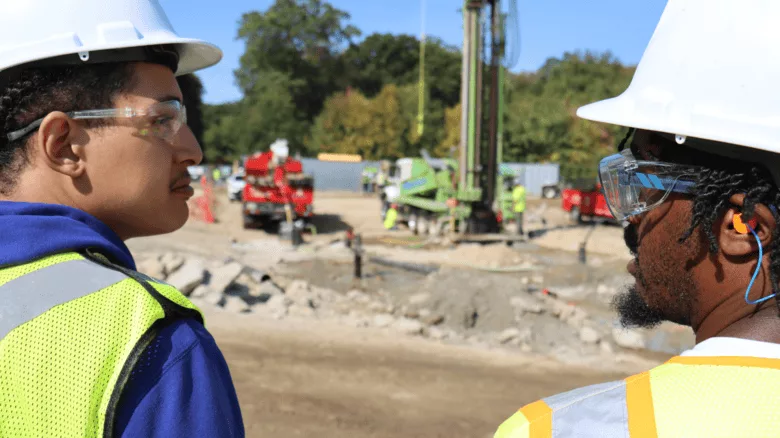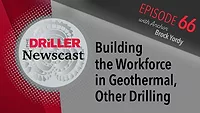Drilling Into the Future: Building the Geothermal Workforce We Need
Introducing Stacy Kinnaly and the Geothermal Drillers Association

Image Courtesy of Skillings & Sons
I am thrilled to introduce myself and the Geothermal Drillers Association (GDA), a member-driven nonprofit founded by drillers for the advancement of drillers, promoting professionalism in the geothermal drilling industry through access to educational, safety, and business resources. Our mission is to create an open-source platform for developing a robust geothermal workforce by teaching drilling methods (fundamentals to advanced) and sharing professional experience, regional best practices, construction safety leadership, and innovation to propel the geothermal drilling industry forward. GDA will complement related association missions and training offerings by focusing on the construction of the geothermal borehole.
It’s a great time to be in geothermal! The thermal energy opportunity is vast and untapped, with geothermal heat sufficient to provide all heating needs in North America according to the IEA’s recent Geothermal Report. Ground source heat pumps (GHPs) and geothermal energy networks have emerged as integral components in the US energy landscape (MIT review, ORNL report), a vision recently corroborated in the DOE report Pathways to Commercial Liftoff: Geothermal Heating and Cooling (Geo Liftoff Report). Still, GHPs account for only 1% of heating and cooling installations nationally, despite having exponentially higher coefficients of performance than air source heat pumps, flattening effects on seasonal electricity loads, and a longer life span with built-in reliability, given that thermal components are fueled by consistent subsurface temperatures and buried out of harm’s way. I know I am “preaching to the choir” in espousing how geothermal can increase the nation’s energy independence, make energy more affordable, enhance public health, and establish a reliable and secure source of heating and cooling.
With the DOE’s Geo Liftoff Report projecting GHP uptake in 80 million homes by 2050, which would require 21,000, two- to three-person drill crews and the creation of 600 boreholes per drill rig per year, it’s more imperative than ever to unite as a geothermal drilling community. This rate of expansion is expected to outpace driller readiness given the time it takes to train drillers (often 2-3 years). Challenges such as the shortage of local drillers and enough local work, a lack of standards, certifications, and apprenticeship programs, and having enough knowledge of drilling techniques that are both considerate of neighbors and protective of aquifers are being addressed in synergies between our organizations and in the market. Campuses, utilities, municipalities and policymakers are moving forward on networked geothermal feasibility studies (hundreds throughout 13 states), informing legislation and instigating industry, regulator, state and utility coalitions (the latter including 29 gas utilities that represent nearly 50% of the nation’s gas consumers). I find personal excitement in the efficient and ethical transition that utility installations enable by bringing heating and cooling to whole neighborhoods at once.
Focus on developing drillers and related professions to be ready as project numbers grow is critical. The industry must optimize geothermal drilling workforce growth together with consistency in practice, pricing, and quality of outcomes related to geothermal boreholes. The GDA aims to support and professionalize geothermal drillers, supporting multiple pathways and entry points to the profession (i.e. for those new to the career and to expand skillsets for existing HVAC, labor, and transitioning veterans, including curricula for community colleges, transitioning gas workers, and other populations). We will gradually catalyze enough regional consumer demand to justify business investment in a geothermal specialty and enable the ability to work in or near your community.
Over the next 12 months, the GDA will refine and customize existing curriculum for these various pathways into a geo drilling career. Companies, of course, need to train their own teams, but our “pre-apprentice” offerings serve as a kind of tee-ball before baseball—designed to accelerate a person’s entry into the profession or prepare them specifically for a project site. GDA will publish our curricula for shared reference while hosting a series of intensives in U.S. locations primed for construction. The GDA team will deploy our mobile training rig wherever geothermal projects are planned and the workforce is ready to be trained. These offerings will grow consistent US geothermal driller training, minimize our collective need to “reinvent the wheel,” and enable more sites to meet their training needs while being sensitive to budgets. GDA also hopes to be a resource for understanding licensing across states and to leverage innovations in technology, such as the ability to train using virtual reality including the access and safety it affords.
We Are Stronger Together
I have become a geothermal superfan. Discussing the environment and engaging our national parks were woven into my children’s upbringing – in fact, our planet’s future evolved as a personal passion in step with the growth of my children. After earning my Certificate in Financing and Deploying Clean Energy from the Center for Business and the Environment at Yale in 2022, I dove headfirst into the sector, most recently managing HEET’s 2024 Geothermal Drilling Tutorial for field technicians. That experience, working alongside emerging professionals who are truly pioneering the future, cemented my decision to join GDA. In just my second week, I attended the IGSHPA conference with founders Brock Yordy and Robert Meyer, where the momentum and promise of the industry were palpable. GDA is gaining real steam, and I’m energized by the caliber of ideas, leadership, and startups we’re engaging in. Joining at this early stage is a privilege—and a challenge I’m excited for.
Geothermal heating and cooling is bringing communities, organizations and unlikely collaborators together. All of us at GDA look forward to partnering with other associations, industry leaders, and those with boots on the ground to optimize workforce growth while generating consistency and quality in ground loop installation.
We hope you will join the Geothermal Drillers Association—please consider inviting someone you know—or at least join the conversation to enable expansion of the most energy efficient and environmentally friendly heating and cooling technology on the planet. Please come find me in Saratoga Springs!
Looking for a reprint of this article?
From high-res PDFs to custom plaques, order your copy today!




